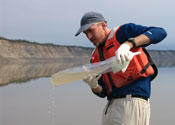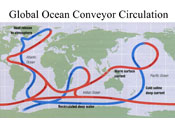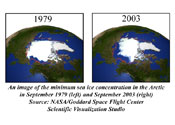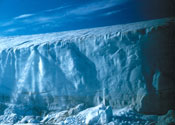 |

For further MBL News and Media Information, contact the MBL Communications Office at (508) 289-7423 or e-mail us at comm@mbl.edu
Study Provides First-Ever Look at Combined Causes of North Atlantic and Arctic Ocean Freshening
A new analysis of 50 years of changes in freshwater inputs to the Arctic Ocean and North Atlantic may help shed light on what's behind the recently observed freshening of the North Atlantic Ocean. In a report, published in the August 25, 2006 issue of the journal, Science, MBL (Marine Biological Laboratory) senior scientist Bruce J. Peterson and his colleagues describe a first-of-its-kind effort to create a big-picture view of hydrologic trends in the Arctic. Their analysis reveals that freshwater increases from Arctic Ocean sources appear to be highly linked to a fresher North Atlantic....More
Resources:
For a media copy of this paper, contact Natasha Pinol in the AAAS Office of Public Programs, +1-202-326-6440, scipak@aaas.org
About Science paper author Bruce Peterson, MBL Ecosystems Center Senior Scientist
http://www.mbl.edu/research/resident/lab_peterson.html
High-Resolution Images:
Please click on thumbnails for high-resolution images
 |
 |
 |
 |
 |
Bruce Peterson is a senior scientist in the MBL's Ecosystems Center, where he focuses on understanding aquatic productivity and global change by studying the cycles of water, carbon, and nitrogen at the ecosystem and global levels.
Photo: Tom Kleindinst, for the MBL
|
Max Holmes collecting a water sample from the Mackenzie
River near the Gwich'en "Indian" village of Tsiigehtchic, Canada.
Photo: Amy Clapp
|
James W. McClelland is an Assistant Professor in the Department of Marine Science at The University of Texas at Austin, Marine Science Institute.
Photo: University of Texas, Austin
|
 |
 |
 |
Polar projection map showing the watershed and ocean domains used for estimates of freshwater anomalies. Solid red lines delineate watershed boundaries used for calculations of river discharge anomalies. Dashed lines separate regions of the ocean surface used for calculations of precipitation minus evaporation anomalies and define the boundaries used for freshwater storage analysis in the Nordic Seas and the North Atlantic Subpolar Basins.
Credit: Science Magazine
|
The giant oceanic salt and heat pump known as the Thermohaline Circulation. Too much fresh water in the North Atlantic and Arctic Oceans might slow down or stop the pump, which could cause a sudden climate cooling for the residents of the United Kingdom, Germany, Sweden, Norway, and eastern North America.
Source: Intergovernmental Panel on Climate Change (IPCC) 2001 Report
|
Bruce Peterson of the MBL's Ecosystems Center and Robert "Max" Holmes of the Woods Hole Research Center on an expedition to collect and analyze water samples from Siberia's Lena River. Part of their study of the freshwater cycle included a chemical analysis of six major Eurasian Rivers known to be contributing to the freshening of the Arctic Ocean. Every river has a different chemical “fingerprint,” which enables scientists to tell how much fresh water each individual river is contributing to the Arctic Ocean.
Photo: A. Zhulidov
|
 |
 |
An image of the minimum sea ice concentration in the Arctic in September 1979 (left) and September 2003 (right)
Source: NASA/Goddard Space Flight Center Scientific Visualization Studio
|
Melt-water streams along the edge of the Greenland Ice Sheet. The rate of melting has increased measurably in recent decades.
Photo: John Hobbie, MBL Ecosystems Center
|
|
Additional Background:
Outside Expert Available for Comment:
Mark Serreze
http://cires.colorado.edu/people/serreze/
Senior Research Scientist
National Snow and Ice Data Center (NSIDC)
E-mail: serreze@kryos.colorado.edu
Phone: 303-492-2963
Funders:
|